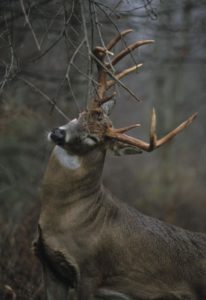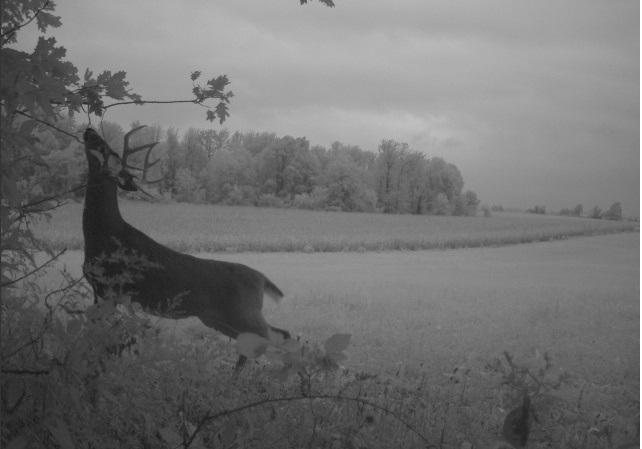Few things get a hunter more pumped than finding a fresh scrape. As you see that black earth freshly pawed, you can only imagine the beast that made it. Better yet, if a large rub or series of rubs are nearby. Look in the dirt carefully. Has the buck used its antlers to dig and scratch. If so, you will find multiple tine lines in the soil, a fantastic find. You want this deer!
Size Matters
 As scrapes appear, the amount of leaves and debris displaced has meaning. Normally, a rub on a large tree indicates the presence of a mature buck, yet there’s no proven relationship between the size of a scrape and the deer that made it. Primary scrapes are often made by multiple bucks and as more deer work the ground the size of the scrape increases. Additionally, does will visit an active scrape adding to sign that’s presenct.
As scrapes appear, the amount of leaves and debris displaced has meaning. Normally, a rub on a large tree indicates the presence of a mature buck, yet there’s no proven relationship between the size of a scrape and the deer that made it. Primary scrapes are often made by multiple bucks and as more deer work the ground the size of the scrape increases. Additionally, does will visit an active scrape adding to sign that’s presenct.
Crime Scene Investigation
When you find that magical buck breeding sign, examine it like one of those TV forensic scientists. You won’t need rubber gloves (unless you touch the licking branch), yet be careful that your shoes or boots aren’t contaminated. You want bucks and does to visit regularly.
Adding scent
A doe-in-heat scent can be added to the scrape or places on a wick where it will attract deer that pass by. A savvy deer hunters once hunted two sides of a ridge. On the way to his stand, he found several fresh scrapes and wanted to keep deer from that spot and onto his side of the ridge. When he encountered a fresh scrape by flashlight, he peed in it, figuring that the human scent would drive deer away.
Ironically, when he came out that evening, he walked past those same ovals and they were freshly pawed. I’m not suggesting that you try this tactic, yet scent in a scrape influences deer behavior.
Well Done
Josh Honeycutt writes prolifically for the Realtree website and did a great job summarizing this subject with images and information. It’s one you will want to share:
https://www.realtree.com/deer-hunting/galleries/the-anatomy-of-a-whitetail-scrape









![The Best Deer Camp Chili [VIDEO] Deer Chili Ingredients, Tomatoes, Chili Spices](/wp-content/uploads/2015/10/Deer-Chili-Deer-Camp-Recipe-218x150.jpg)








![How to Call Elk Early in the Season [VIDEO]](/wp-content/uploads/2016/08/byers003-218x150.jpg)




![Idiots Disturb Hunter: How Would You Have Handled It? [VIDEO]](/wp-content/uploads/2015/10/DSC00110-e1474487693878-100x70.jpg)
![Albino Buck Shocked to Shed His Antlers [VIDEO]](/wp-content/uploads/2015/10/AlbinoDeer-100x70.jpg)